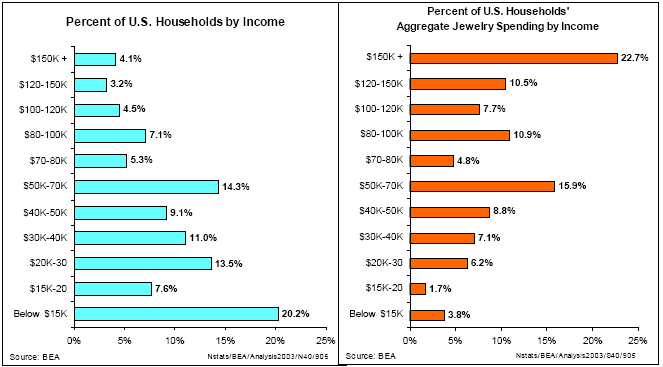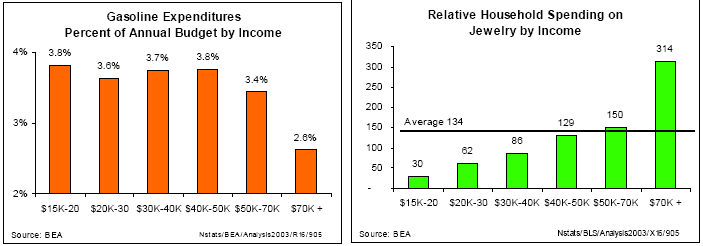IDEX Online Research: Jewelers' Best Customers Can Buy Both Gasoline and Jewelry
September 19, 05
Sticker shock at the gasoline pump has jolted Americans’ spending habits. A 50% price increase in a week for unleaded “regular” gasoline coupled with spot shortages and long lines has caused shoppers to pause their otherwise unbridled spending.
In 2003, when gasoline averaged $1.55 a gallon, the typical American family spent roughly $1,300 annually on gas and oil; this represented about 3.3% of their total spending. With gas prices over $3.00 per gallon today, the average American will spend more than 6% of their take-home pay on fuel for automobiles.
Consumers, unlike governments, can’t print more money to plug a deficit budget. Thus, higher gasoline prices will cause spending cutbacks elsewhere.
While higher gasoline prices will affect everyone, some shoppers will feel the impact more than others. “Averages” don’t tell the story for the jewelry industry. There is no “average” jewelry customer. For jewelers, their best customers are concentrated in households with more than $50,000 annual income. And for those customers, the impact of higher gasoline prices will be minimal.
The graphs below explain this concept. For example, looking at the top line of each graph, almost 23% of all jewelry sales are generated by consumers with household incomes above $150,000 annually; these households represent just 4% of the total households in America. For jewelers, the mother lode is concentrated in households with incomes above $50,000 annually: 38% of all American households make more than $50,000 annually; their aggregate spending on jewelry represents nearly 75% of all jewelry sales in America.

These same wealthy households also spend less, as a percentage of their income, on gasoline for their cars (see graph below). In other words, gasoline prices can continue to rise before their budgets are crimped. The graphs below illustrate relative household spending, by income group, on both gasoline and jewelry.

In addition to rising gasoline prices, American consumers can expect higher energy costs – electricity, heating oil, natural gas – as a result of soaring oil prices. However, even when utility costs are added to the analysis of consumer budgets, the result is the same: lower income shoppers – 42% of U.S. households who make less than $30,000 annually – will feel the pinch, but their very modest spending on jewelry – 12% of the industry total – simply won’t be missed by most jewelers.
There is one factor which cannot be quantified: the impact of “perception.” Even if jewelers’ best customers – those earning over $50,000 annually – can afford jewelry, will they continue spending at their current rate?
There are at least two arguments which suggest that they may not only continue to spend on jewelry, but that spending might rise modestly.
- If consumers cut back on the number of miles they drive, their gasoline spending will moderate. The budget is re-balanced, and jewelry spending remains intact (or perhaps rises slightly).
- Jewelry is a feel-good product. When times are tough, consumers may step up their spending on jewelry to help sooth emotional stress caused by gasoline shortages, lines at the pump, and budget-busting gas prices.
If this optimism seems too hard to swallow, don’t take our word for it. Advertising Age magazine just ran an article titled, “Will oil spoil spending? Not among affluent”. Quoting from that article, “The reality is that income gains have made $3 gas affordable for most households. However, marketers selling to low-income households will face obstacles. Affluent households . . . will be just fine.”
Further, Unity Marketing recently conducted research which concluded that “Luxury consumers are indifferent to rising gas prices and the threat of a bursting housing bubble.” The research suggests that luxury consumers believe they can weather most any economic storm. Further, these higher income consumers are not letting rising gas prices or the potential threat of a housing bubble bust affect their buying behavior.
Finally, while it is not possible for consumers to indulge in deficit spending by printing money, they do have the ability to spend more than they make in the short term. Shoppers can tap their savings accounts for current needs, as they did in July when the American savings rate went negative for the first time in history. We expect to see subsequent months with a negative savings rate, until U.S. consumers learn how to cope with high energy prices.
For merchants, though, the future is not bleak. Culturally, most Americans believe they were born to shop. Shopping in America is a social and recreational experience first and foremost. That’s not about to change.